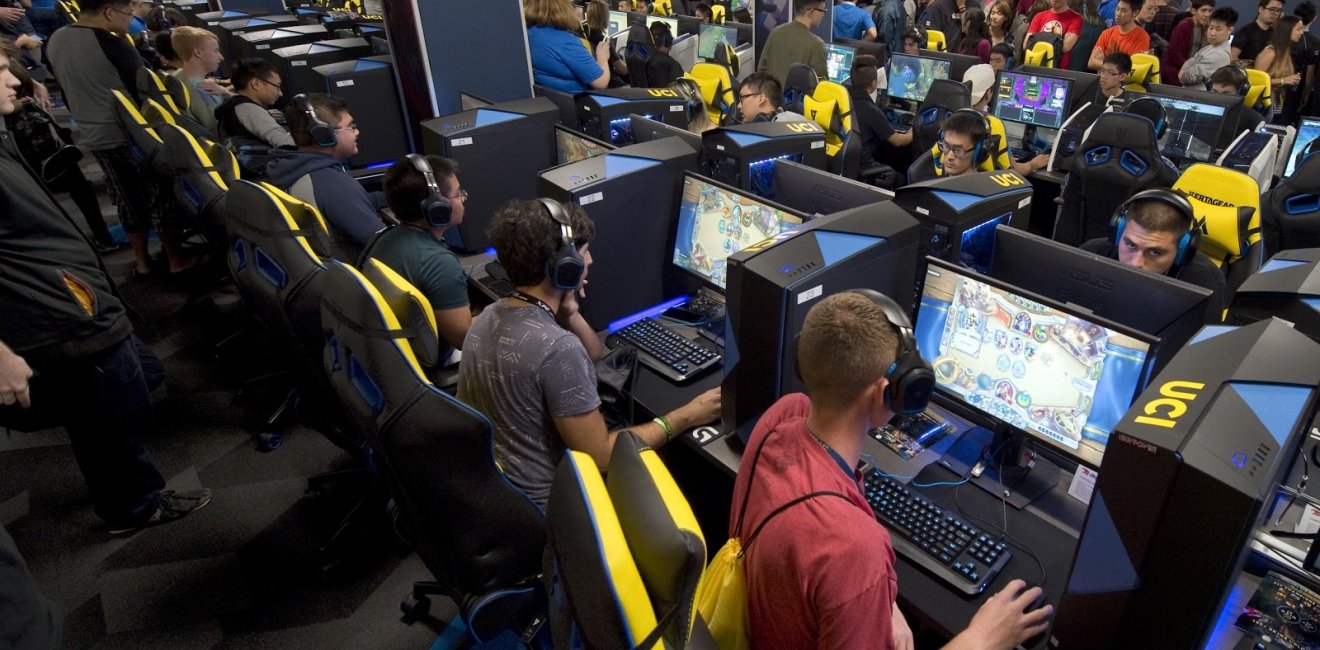
A blog of the Science and Technology Innovation Program

Students compete at the first ever public university esports arena. Image Copyright, University of California, Irvine.
In the small town of Elida outside of Lima, Ohio, five students waited to compete. Like any team of athletes, they were nervous and excited for game day. They had drilled their techniques, studied the game tape on competitors, and built bonds across their team. Now, they sat at their computers, mice in hand, with avatars selected. The music swelled as the other team joined the video game. Now it was time to compete.
At its core, esports is a form of competitive video game play where video games ranging across several different genres (action, strategy, sports, and others) are played as if they were a sport. Internationally, esports is often highly professionalized, with teams, players, sponsors, management staff and leagues that are all reminiscent of traditional sports leagues.
Mark Suter, a computer science and game design teacher at Elida High School, sponsored the creation of Elida’s esports team. The team competes in online video games and allows students to learn skills like entrepreneurship, teamwork, and management. Mark is quick to point out that it’s the students that run the show. “My role as the sponsor is more about asking them good questions,” Mark says, “then having them flesh out the details and doing the legwork so students hold the major management responsibilities. Questions like, ‘What does our group stand for? Why do we exist? How do we communicate with members on different schedules? How will we get funding?’”
Initially the team lacked the funds and equipment needed to compete in online video game tournaments. They took a page from other athletics programs and fundraised money from local businesses to outfit their team with suitable desktop computers. Learning non-cognitive skills like teamwork and perseverance is only one facet of the program. Mark and his students are also working to incorporate elements of English class into the afterschool program as well as developing video production skills so that the team can stream their matches live online.
Student involvement in esports and competitive gaming is rapidly growing in schools and at home. Just how big is the field?
-
According to the High School Esports League, students from over 500 high schools have competed in their competitions since it was founded in 2014.
-
League of Legends, one of the most popular games in esports, has reported that they have active clubs in over 750 colleges and universities, reaching an estimated 80% of the higher education population.
-
Over 35 colleges and universities now offer scholarships to esports student athletes as recognized by the National Association of Collegiate eSports.
-
The esports market is worth nearly $700 Million.
-
Esports viewership reaches an audience of 385 Million worldwide.
Because so many professional esports gamers are young, there is a large overlap between students and “pro-gamer” populations. Some pro-gamers begin to win competitively before they are legally able to drive a car, and many retire right after their peers are graduating from college. Players who are also students must strike the right balance between gaming and school activities. Collegiate esports athletes in particular sometimes train for 20 hours or more during the school week. Esports requires dedication, which often translates into a commitment to play, watch, research, and otherwise live video games.
This is all the more reason why educators and administrators need to be informed and engaged in these conversations with their students. If your child or student is involved in esports, having a conversation early on about their play habits can help promote positive play behaviors.
Mark points out that many students’ families have been supportive of their students playing esports at school. As one grandparent put it, "I want these students to have a place they can feel included. My grandson doesn't play a sport, so this IS his sport. This is a team where he belongs."
As esports continues to grow and affect the student population, we expect that the body of research and pedagogy around esports will grow as well. Initial research on connections between players’ play and cognitive skills has been promising. We anticipate that more educators will share their stories, that organization among schools will continue to increase and formalize, that more research will be conducted linking the development of cognitive and non-cognitive skills and play, and that data used in these games will be leveraged in ways that may lead to more personalized learning opportunities in the classroom.
James Collins works in the Office of Educational Technology at the U.S. Department of Education. He works across a broad range of ed tech policy, from early learning to higher education, and also leads the office’s work on game-based learning and assessment as well as XR and maker education. He previously worked at the Smithsonian’s Center for Learning and Digital Access.
Elizabeth M. H. Newbury, PhD, is the Program Associate for the Serious Games Initiative at the Woodrow Wilson International Center for Scholars. As a graduate student at Cornell University, her research has focused on understanding esports audiences, with her dissertation on the topic of esports fandom. Now at the Wilson Center, she focuses on designing games for the purpose of making policy research engaging and accessible to the broader public audience.
Authors




